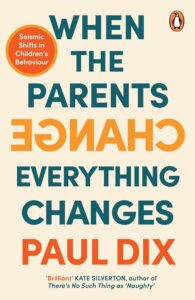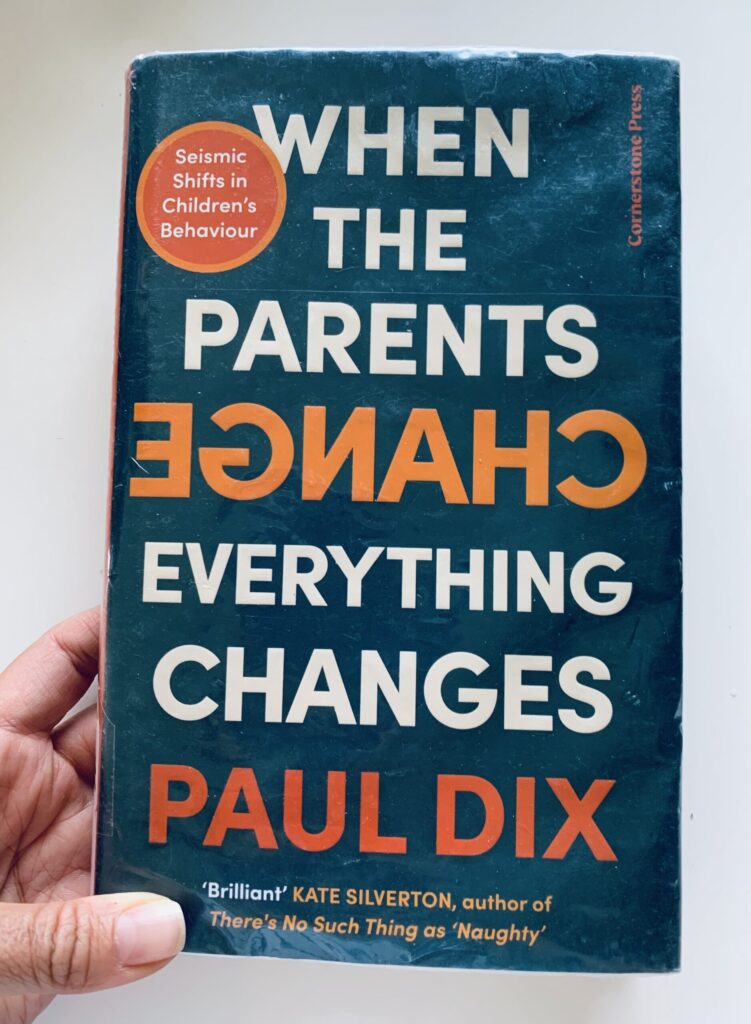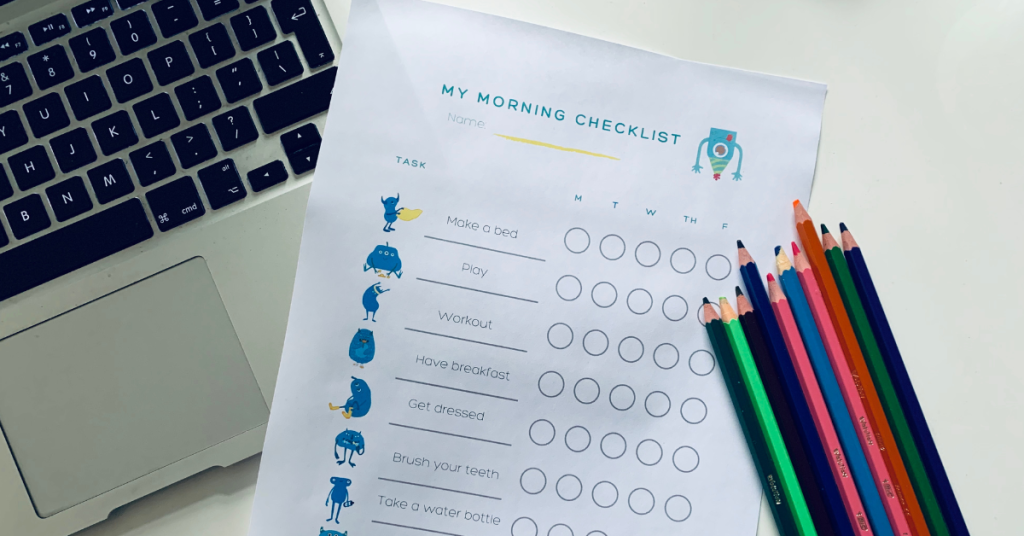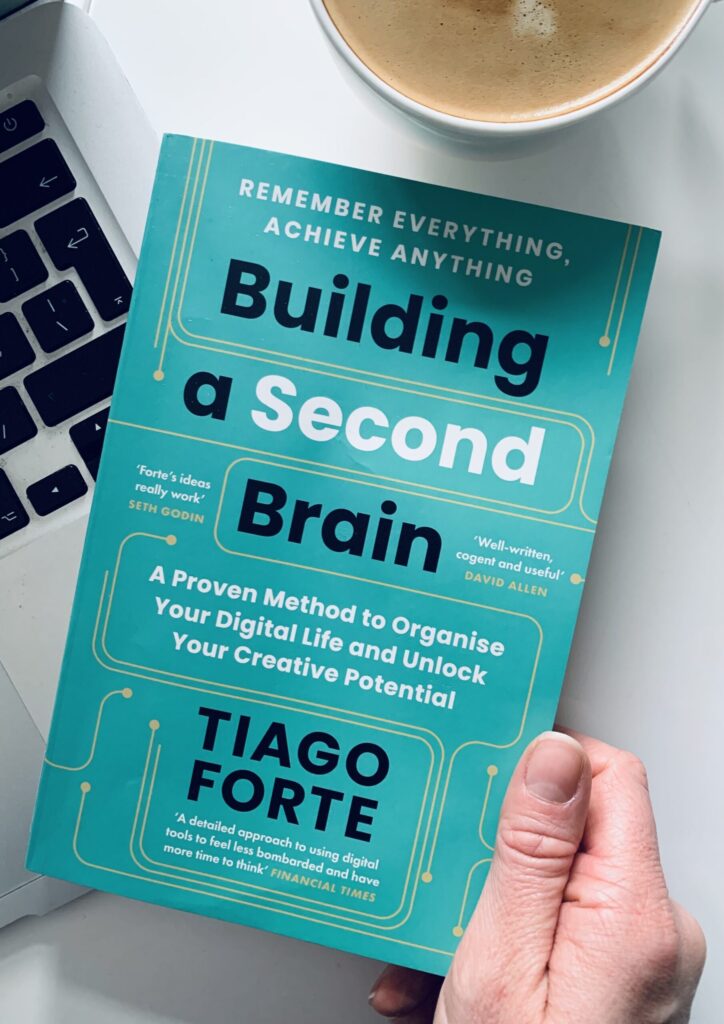 When The Parents Change, Everything Changes. Book Summary
When The Parents Change, Everything Changes. Book Summary
Seismic Shifts in Children’s Behaviour
Paul Dix
Penguin (Sep 2023)
About Paul Dix
As a teacher, leader and teacher trainer, Paul Dix has been working with the most difficult behaviours in the most challenging contexts for the last 30 years. Miraculously Paul studied at Homerton College Cambridge after countless attempts to sabotage his own education. Paul works across Local Authorities building relational practice in schools and Childrens’ Services.
Paul has advised the Department for Education on Teacher Standards, given evidence to the Education Select Committee and worked with the Ministry of Justice on Behaviour and Restraint in Youth Custody.
His book When The Adults Change, Everything Changes has been a best seller for 6 years selling 150,000 copies.
About The Book
“When the Parents Change, Everything Changes is not just a groovy title. It is the central principle you need to save your child’s sanity and your own. Without it, nothing else will matter.
That doesn’t mean you need to become a different human being overnight. This isn’t a magic behaviour solution. But there are deliberate, strategic tweaks you can make in your behaviour towards your child that will in turn transform theirs towards you. […]
Everything starts with your emotions. Focus on the atmosphere you create in your home. With your behaviour you can create an aura of calm. Not a pretend calm or a side order of calm. You need to become so good at calm that it becomes the pervading mood in every interaction.
That calmness will in turn create a pattern of consistent, persistent parenting. But consistency takes a plan. A plan for the everyday and for the small shifts that will make a big impact. This is a plan that doesn’t ask you to choose between strict discipline and having a great relationship with your child; between having a successful career and being a brilliant parent. And you don’t have to spend any money to achieve it.
This consistency will reach its zenith in a positive, relational approach to parenting. It will give you the chance to be the parent you really want to be: caring and loving, while holding boundaries and successfully teaching behaviour. Through all the ups and downs, what is most important is your relationship with your child. Relational parenting respects that. It ensures that even in the trickiest moments, your relationship is never in question.
Calm parenting. Consistent parenting. Relational parenting. These principles form a concrete base for your parenting regardless of the age of the child. From these foundations, we will develop a completely new way for you to behave and for your child to behave.”
If you’ve been following my blog for a while, you probably know that I’m a big believer in the idea that good parenting starts with us, the parents. So, when I stumbled upon Paul Dix’s book When The Parents Change, Everything Changes, I immediately put aside all the other books on my reading list and dived right in.
Now, Paul Dix isn’t just any educator—he’s the kind of teacher every child would dream of having. His first book, When The Adults Change, Everything Changes, became a national bestseller here in the UK, and it’s easy to see why. Thousands of teachers and schools have adopted his approach, including my boys’ school. So, when one of the teachers mentioned Paul Dix’s work at a recent parents’ event, my interest was piqued.
While When The Adults Change, Everything Changes was geared primarily towards educators, this book is for us parents. Dix’s key message is simple but profound: our own behaviour as parents shapes our children’s behaviour. When we shift our focus to managing our own emotional reactions and invest the energy into building strong relationships with our kids, everything changes at home. Great parenting is built on calm consistency.
I absolutely LOVED this book. It’s packed with brilliant ideas, practical techniques, and effective scripts that make it feel like you’ve got a parenting coach in your back pocket. The book gives you a clear roadmap to becoming a calm, consistent, and connected parent. Plus, it’s fantastically written—great structure, relatable life examples, and a tone that feels like you’re chatting with a wise friend.
In these notes, I’ll touch on a few of my favourite ideas from the book, but trust me, you’ll want to grab your own copy to dive deeper.
Let’s jump straight in.
Key Insights
Gain Emotional Control
“The emotional mind plays havoc with your ability to be rational and consistent. But if you focus your energy on controlling your emotions, rather than trying to control the child, you will soon be taking steps forward.”
If you want to stop yelling at your kids and be more rational and consistent, the first step is to figure out how to keep your emotions in check.
This isn’t a new idea, but it’s probably the hardest to pull off. Why? Because it requires some deep self-reflection. What triggers your emotional reactions? What are your emotional “buttons”? How do you usually react—both verbally and non-verbally—when your child misbehaves?
Once you identify your buttons, you can start working on defusing them (spoiler alert: it’s not easy). Some days, you’ll handle your child’s behavior like a zen master; other days, you might respond with frustration or lose your cool (trust me, I’ve been there). And that’s okay. Paul suggests that if we can get it right 8 out of 10 times, our kids will see us as consistent and reliable.
For those 2 out of 10 times when you slip up, the plan is simple: recognize the mistake, apologize if necessary, and get back on track.
Challenge yourself to go a week without yelling. Just one week. Then try for another. Keep going until it becomes second nature.
P.S.: If you want to dive deeper into managing your emotional reactions, check out our notes on Philippa Perry’s The Book You Wish Your Parents Had Read, Hal Runkel’s Screamfree Parenting, and Becky Kennedy’s Good Inside.
“This is How We Do It Here”
“Imagine a sign hanging over the front door that says ‘This is how we do it here’. The behaviours that work for you outside of these walls are not in your direct control. But when you walk through that door, everyone knows: ‘This is how we do it here’.
Define it. Agree it. Stick it on the fridge if you want to.”
I love this mantra: “This is how we do it here.” It’s the backbone of your family culture. It’s how you create consistency, and consistency makes kids feel safe.
So here’s a task for you:
“Write down a list of How we do it here’ right now, before any changes have been made. Think about how you deal with poor behaviour right now, how you celebrate their over-and-above behaviour, and what your current expectations are. Now write down the changes you would like to make and draw up a list for the future. Share it with your child, post it on the fridge and return to it every day in the first few weeks.”
Paul dives deep into setting boundaries, rules, and routines at home—his book is packed with practical strategies. I highly recommend giving it a read.
P.S.: A family manifesto is a great way to visualize “This is how we do it here.” Check out our step-by-step guide on how to create one.
Positive, Relational Parenting
“To make your relationship with your child as strong as it can be needs your constant, careful attention. Just like every other relationship that you have. Strong relationships are not accidental or circumstantial. They change and often fail when you stop working on them.
With your own child, that work rests on everyday habits. It isn’t the grand gestures (‘I know I haven’t spoken to you for months but we are going to DISNEYLAND tomorrow!’) or big talks (‘You may only be six, but we need to talk about your life choices: have you considered chartered accountancy?’). Relationships are built on small, daily actions.
Above all, they are built on the elements of your child’s behaviour that you choose to notice. You can focus on rules and boundaries as much as you like – but it is what you comment on that most affects a child’s internal monologue. How you talk to your child matters. What you notice about their behaviour matters most of all.”
I couldn’t agree more. Good parenting hinges on a strong, healthy relationship with your child. And that relationship needs daily work.
One of the most powerful yet simple techniques that helps you build that relationship while teaching the right behaviour is positive noticing. It might be tough at first since we’re hardwired to nitpick, but start small: ‘That’s lovely,’ ‘Thanks for sharing your crayons with your brother,’ ‘I just love the way you do that.’
Aim to notice at least 10 positive things about your child every day. Make it a habit: notice when they make an effort (growth mindset praise), say something positive before they leave for school, reflect on the good stuff at the dinner table, or acknowledge positive behaviour at bedtime. It’s life-changing:
“Small things, regularly noticed, are the tiny bricks that build your child’s confidence.”
That reminds me of Stephen Covey’s Emotional Bank Account metaphor – it is a great way to understand and nurture your relationship with your child. Think of it like a real bank account, but instead of money, you’re making deposits and withdrawals of trust, love, and goodwill. Positive actions—like positive noticing, keeping promises, and spending quality time—are deposits that build up this account, strengthening your connection. Negative actions—like criticism, breaking promises, or punishments—are withdrawals that deplete the account, weakening the relationship. By consistently making deposits, you can maintain a positive balance and ensure a strong, trusting relationship, even when conflicts arise.
Get Your Scripts and Mantras Ready
“What three messages do you want your child to hear whenever things go awry? What if you said the same things to your child in response to their behaviour every day for the next thirty days? What impact would it have on your relationship and their behaviour? I am sure that you would want your words to be affirming, encouraging and positive. These phrases are your positive mantras. They are yours to determine.”
Scripts and mantras are like cheat codes for parenting. They’re powerful tools that help you discipline your child effectively while staying calm and consistent. The trick is to plan and practice them so that when things start heating up, you can hit pause and use the right words to handle the situation.
“Remember our rule about…”, “No pressure, no diamonds”, “We are problem solvers.”
What are your mantras? Pick three you can stick with, and then get ready to play the long game.
When things spiral out of control, it’s easy to say the wrong things and unintentionally escalate everything. That’s when scripts come in handy. Paul shares a powerful “de-escalation monologue” that helps you reset boundaries and address behaviour. Here’s how it works:
- Connect: No matter how frustrated you are, always connect first. “As long as you’re okay, that’s what’s important. Come give me a hug; we’ll deal with the phone in the microwave later.”
- Notice: Be clear about why you’re addressing the behaviour. “I stopped you because I noticed you broke our safety rule. The stairs aren’t a ski jump, you’re not Eddie the Eagle, and that saucepan isn’t an official GB helmet.”
- Consequence: Tell your child what the consequence is, making sure it’s not punitive. “I need you to clear all the cushions and blankets and put them back, then meet me in the kitchen for a chat.”
- Reframe: Remind your child of a time they behaved well. “Yesterday, you played safely outside and made sure nobody got hurt. That’s what I need from you today.”
- Thank: “Thank you for listening.”
Two key tips: always use an assertive tone and language (e.g., “I need you to…”), and always separate your child’s personality from their behaviour (replace “stop being so naughty” with “I won’t let you hit your brother”).
The Smallest Consequence That Works
“The goal, above all, is to avoid punitive consequences. “Sit there for a minute’ is not punitive; ‘Sit there for an hour’ is. ‘Go to your room and I will come and speak to you’ is not punitive; ‘Go to bed without dinner’ is. I am taking the toy away for now’ is not punitive; ‘I have lobbed your toy out of the eighth-floor window’ is.
Punitive consequences seek to ‘drive the message home’, but what they actually do is damage trust. So instead, you need to impart the lesson that is required, nothing more. What you are looking for is the smallest consequence that is effective.”
That’s from the chapter called “Proportionate Consequences.” Consequences get a pretty polarized view in parenting books, but I really liked how Paul explained using consequences correctly when disciplining a child.
Check out the book for more tips.
Restorative Conversations
“The defining characteristic of a restorative conversation is that it seeks to repair damage. When trust has been broken or relationships have been harmed, they come to your aid. Sometimes they will replace punishment, sometimes they will run alongside other consequences. Restorative conversations are important, however, as their focus is on understanding and learning.”
As Dan Siegel and Tina Payne Bryson remind us in their great book No Drama Discipline (check out our notes):
“The word “discipline“ comes directly from the Latin word disciplina, which was used as far back as the eleventh century to mean teaching, learning, and giving instruction. So, from its inception in the English language, “discipline“ has meant “to teach.”
If you want to teach your child the right behaviours and instil important skills like self-reflection and perspective-taking, restorative conversations are a powerful tool in your parenting toolbox.
The idea is simple—when you need to address your child’s behaviour, have a conversation. But the setup is key: aim for a one-on-one chat when you’ve regained your emotional balance and your child is ready to engage. The best approach? Talk while you’re walking, playing with playdough, or building LEGO—anything to keep it casual. It shouldn’t feel like an interview where you’re facing each other across a table.
Here are some questions you can ask your child (keep it simple—five questions per conversation, two for younger kids):
- What happened?
- What were you thinking at the time?
- What have you thought since?
- Who has been affected and how?
- What should we do to put things right?
- How can we do things differently in the future?
- Why do you think things went wrong?
- Where do we go from here?
- Who could help us with the next steps?
I found this approach quite similar to Ross Greene’s Collaborative Problem Solving technique from his great book The Explosive Child – check out our notes for more.
It’s so much more effective than punishment.
Action Steps For You:
- Create Your Family’s Guiding Principles: “This is how we do it here”. Start by writing down a list of “This is how we do it here.” This list should reflect how you currently handle behaviour, celebrate achievements, and set expectations. Once you have your baseline, think about the changes you want to see and create a new list for the future. Share this with your family, stick it on the fridge, and revisit it regularly. This will help establish consistency and clarity in your family dynamics.
- Master Positive Noticing: Aim for 10 Positives a Day. Commit to noticing and acknowledging at least 10 positive things about your child every day. It could be something small, like sharing a toy, or a bigger effort like completing a task. Make it a habit to give specific praise and reinforce positive behaviour throughout the day. Over time, this practice will help build your child’s confidence and encourage more of the behaviour you want to see.
- Use Restorative Conversations for Discipline. When you need to address your child’s behaviour, opt for restorative conversations instead of punitive measures. Set the stage for a calm, one-on-one conversation where you can guide your child through understanding what went wrong and how to make it right. Ask questions that promote reflection and learning, like “What happened?”, “Who was affected?”, and “How can we fix this?”. This approach not only teaches responsibility but also strengthens your relationship with your child.
Quotes From The Book:
“Your behaviour is the only behaviour over which you have absolute control. To change your children’s behaviour, you first need to change your own.”
“It is easy to imagine that your child will forgive you for anything. They won’t. If your behaviour plan is built on the idea that your relationship is unbreakable, then it has bad foundations.”
“When your child doesn’t know how to behave, that means you haven’t taught them well enough. This should be an internal frustration, not one reflected back at your child.”
“You don’t make children behave better by making them feel bad about themselves.”
“The ferocity of the punishment doesn’t determine future behaviour, but it might determine your future relationship.”
“Children who regularly lose control of their emotions don’t need you to lose control of yours. They need help, not anger. They aren’t ‘naughty’ or ‘difficult’ or ‘trouble’. They are dysregulated and struggling to regain control – and that’s a state that nobody really wants to be in.”
“Your child is emotionally immature by design. Expecting them to surpass the expectations for an adult is unfair.”



